Exploring True Gem Moissanite: A Comprehensive Review
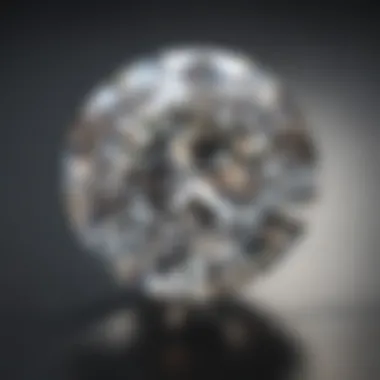
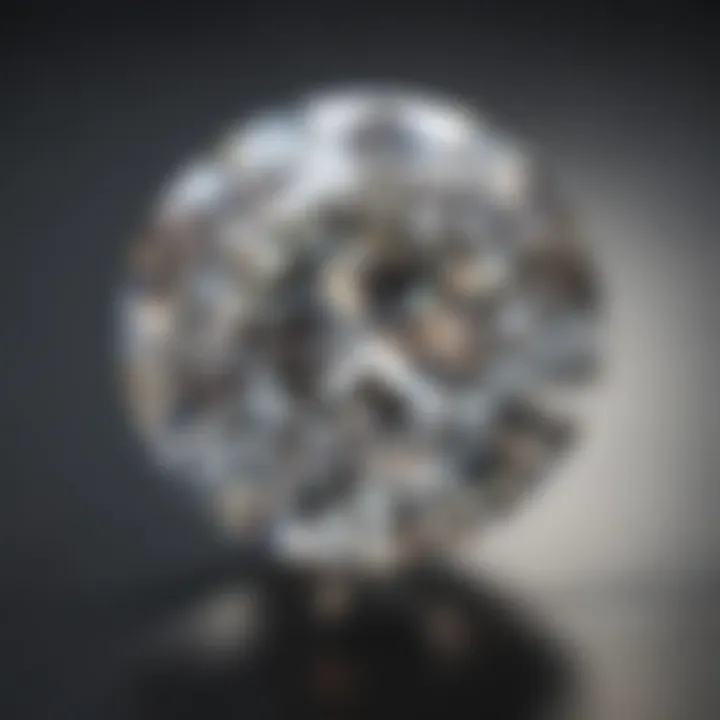
Intro
Merging the allure of diamonds with economical sensibility, moissanite has carved out a niche in the world of gemstones. Shimmering with brilliance, this gem often invites comparisons to the more traditional diamond. But what truly sets moissanite apart? This article seeks to shine a light on its unique characteristics, historical context, and why it’s increasingly becoming the gem of choice for jewelry enthusiasts and potential buyers alike.
Gemstone Overview
Definition and Characteristics
Moissanite, a silicon carbide crystal, is prized for its striking beauty and durability. Unlike diamonds, which are composed of pure carbon, moissanite offers a distinctive sparkle, often referred to as “fire,” resulting from its higher refractive index. This property not only enhances its visual appeal but also gives it a different light performance relative to diamonds, leading many to choose it as an ethical and cost-effective alternative for engagement rings and other fine jewelry.
Its hardness scores an impressive 9.25 on the Mohs scale, making it one of the toughest gemstones available. With a variety of cuts, including round, oval, and radiant, moissanite caters to diverse personal tastes, allowing lovers of gems to find a piece that truly resonates with their aesthetic preferences.
Classification of Gemstones
Moissanite falls into the category of synthetic gemstones, which differ from natural stones like emeralds or sapphires. It mimics the appearance of these natural gems while providing benefits like lower cost and ethical sourcing. Here’s a brief breakdown:
- Natural Gemstones: Formed over thousands of years within the Earth’s crust. Examples include diamonds, rubies, and sapphires.
- Synthetic Gemstones: Manufactured through human intervention. Moissanite is a prime example, created using advanced technological methods.
Key Takeaway
Moissanite's blend of beauty, durability, and ethical considerations positions it as a noteworthy contender in the gemstone market, drawing attention from budget-conscious shoppers and environmentally-aware individuals.
Historical Significance
Ancient Uses and Cultural Importance
While the discovery of moissanite in its natural form is rare, occurring in meteorites, its history is fascinating. Originally discovered by Henri Moissan in 1893, the gem's association with celestial origins infuses it with a unique narrative. In its early days, the gem was viewed with awe, likened to diamonds in brilliance but recognized for its cosmic roots. Ancient civilizations often attributed significant meanings to stones, and while moissanite might not have a deep historical legacy like sapphires or rubies, its modern journey is notable.
Myths and Legends Surrounding Gemstones
Gemstones have always been steeped in mythology. Moissanite, much like its diamond counterpart, is enveloped in romantic notions. It’s often said to symbolize endurance and unwavering love, making it an ideal choice for couples wanting to commemorate their commitment. The celestial nature of moissanite gives rise to legends of protection and guidance, echoing the belief that those wearing it are favored by the universe.
The stark contrast between how traditional gemstones bear tales rich with historical anecdotes and moissanite's emerging story reflects an evolving narrative in fine jewelry. While it may not have ancient myths aligned with it, its growing popularity suggests that new legends may soon surface, weaving moissanite into the fabric of modern romance.
By examining the facets, both literal and metaphorical, of moissanite, potential buyers can develop a nuanced appreciation for its significance in today’s jewelry landscape. That understanding equips them not just with a choice of gem, but with an object carrying a story, evoking both history and personal connection.
Preamble to Moissanite
In recent years, moissanite has taken center stage in the gemstone arena, capturing the attention of jewelry enthusiasts and casual buyers alike. The significance of this topic lies not only in its aesthetic allure but also in the myriad qualities that distinguish it from other gemstones, particularly diamonds. As a synthetic alternative, moissanite is rapidly gaining traction as a viable option for engagement rings and fine jewelry, inviting potential buyers to explore its unique properties, market presence, and the overall buying experience.
The growing popularity of moissanite stems from its remarkable brilliance and fire, which rivals that of traditional gemstones. Potential buyers benefit from understanding this gemstone’s qualities and the advantages it offers, including cost-effectiveness and environmental considerations. Moreover, by elucidating the characteristics of moissanite, this article seeks to address common queries and misconceptions—vital for informed decision-making.
Defining Moissanite
Moissanite, originally discovered in a meteor crater by French chemist Henri Moissan in the late 19th century, is a gemstone composed of silicon carbide. Its natural occurrence is exceedingly rare, a fact that elevates the value of the synthetic version extensively manufactured today. Moissanite can exhibit properties similar to that of diamond, including excellent hardness, which tops the Mohs scale at 9.25.
The gemstone is known for its incredible light performance. As light enters and exits the stone, it reflects and refracts in a spectacular dance, setting it apart from other gems. This characteristic gives moissanite its dazzling appearance, making it not just a choice but a statement among gemstone enthusiasts.
Moreover, the price point associated with moissanite offers a substantial incentive. The cost can often be less than half that of a similarly-sized diamond, which presents a fascinating opportunity for buyers seeking beauty without the unyielding financial burden.
In summary, understanding what moissanite is and what it represents is critical for anyone looking to invest in fine jewelry. By recognizing its origins, composition, and the unique appeal it holds, potential buyers can better appreciate the intricate world of gemstones, allowing them to make thoughtful and satisfying purchases.
The Origins of Moissanite
The story of moissanite is both fascinating and layered. Understanding its origins is crucial for gemstone enthusiasts, collectors, and jewelry designers alike; it sheds light on the unique qualities that set this stone apart in an ever-evolving market. The journey begins with its natural discovery and extends into contemporary synthetic production, which has made moissanite widely accessible. By delving into the origins, we can appreciate not just the gem itself but also the craftsmanship that surrounds its creation.
Natural vs Synthetic Origins
Moissanite was first discovered in 1893 by the French chemist Henri Moissan while he was studying a meteorite in Arizona. He found tiny crystals of silicon carbide, the primary component of moissanite, which sparked a curiosity that endures to this day. Natural moissanite is exceedingly rare, found mostly in meteorite material or in some igneous rocks. This scarcity makes natural moissanite an interesting but impractical choice for most jewelry applications.
Conversely, the synthetic origin of moissanite dramatically shifts the narrative. With advancements in technology, manufacturers have been able to create high-quality synthetic moissanite in laboratories. This process essentially replicates the conditions that occur in nature, resulting in stones that not only possess the same physical and chemical properties but are also evaluated ethically.
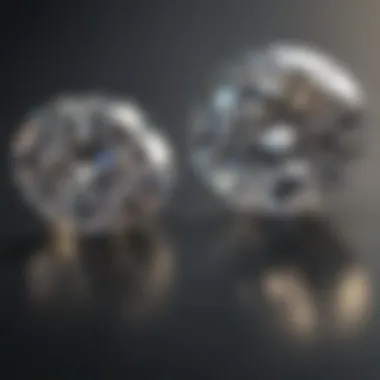
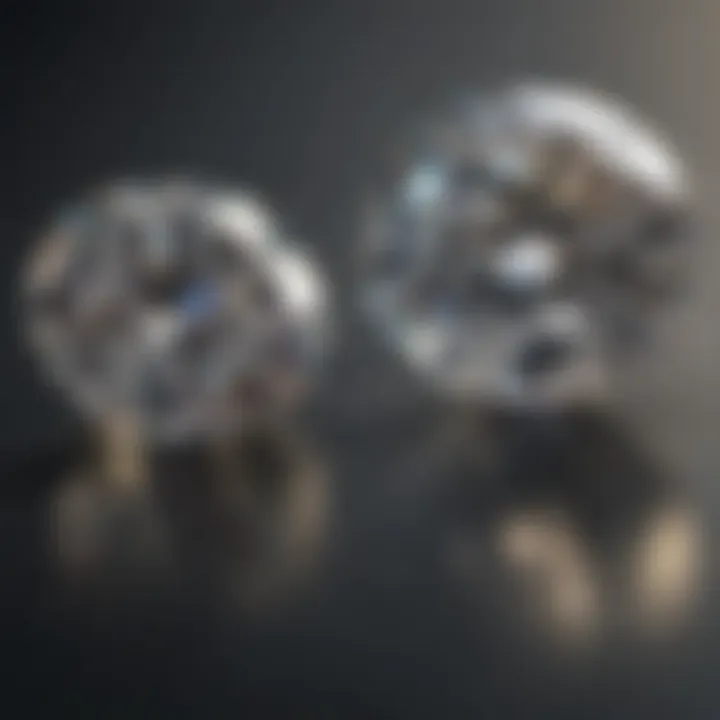
Benefits of Synthetic Moissanite:
- Affordability: Generally more cost-effective than naturally occurring stones.
- Ethical Production: Synthetic stones eliminate mining concerns.
- Uniform Quality: Controlled conditions lead to consistent quality across batches.
Historical Context
While the origins of moissanite might seem straightforward, they are intertwined with the broader history of gemstones. After Henri Moissan's initial discovery, the gemstone's potential remained underappreciated for decades. In the late 20th century, as the demand for alternative stones grew amidst rising diamond prices, synthetic moissanite entered the market. This marked a turning point.
The commercialization of synthetic moissanite began with the work of a few pioneers like Charles and Colvard in the 1990s. They effectively introduced this gemstone as a brilliant diamond alternative, promising similar aesthetics at a fraction of the cost. This revelation not only transformed consumer preferences but also challenged traditional views on what defines a precious gemstone.
Now, as a testament to its growing popularity, moissanite has cemented its place in jewelry stores around the world, often capturing the hearts of new generations searching for ethical and stunning options. This history reminds us of the gem's transformation from a scientific curiosity to a widely accepted symbol of love and commitment.
"Understanding the origins of moissanite not only informs choices but enriches the appreciation for this remarkable gemstone."
Understanding Moissanite's Unique Properties
When venturing into the realm of gemstones, understanding the unique properties of moissanite is essential. This knowledge is not just academic; it can significantly influence purchasing decisions and appreciation of this stunning alternative to traditional gems. \n\nUnderstanding moissanite's unique properties helps potential buyers grasp its appeal. By comparing it with other gemstones, buyers can assess factors like brilliance, durability, and value. These characteristics can no longer be overlooked, especially for those who appreciate the artistry in jewelry design.
Chemical Composition
Moissanite is primarily composed of silicon carbide (SiC), a compound that contributes significantly to its resilience and brilliance. With a hardness rating of 9.25 on the Mohs scale, it ranks just below diamonds, making it an exceptionally durable choice for everyday wear.
This composition also impacts how moissanite interacts with light. The arrangement of silicon and carbon atoms leads to unique optical properties that give moissanite its famous sparkle. In essence, understanding the chemical makeup of moissanite offers essential insight into its durability, performance, and visual appeal.
"The brilliance of moissanite stems from its unique chemical structure, making it a coveted choice for those seeking lasting beauty in jewelry."
Physical Characteristics
The physical attributes of moissanite are nothing short of fascinating. Moissanite showcases a color range that can vary from near-colorless to slightly tinted stones. While some may prefer a completely colorless appearance, others appreciate the subtle hues that certain variations possess.
Additionally, the transparency of moissanite is impressive. When viewed closely, it offers clarity that rivals many traditional gemstones. This clear visibility elevates its status in the eyes of collectors and jewelry designers alike.
In terms of cut, moissanite can be fashioned into various styles that enhance its inherent beauty. Whether it's a classic round cut, a modern princess cut, or an intricate cushion shape, the adaptability of moissanite is a notable aspect that designers have come to value.
Brilliance and Fire
Brilliance and fire are pivotal characteristics that distinguish moissanite from other gemstones. The term "brilliance" pertains to how much light is reflected from the stone's surface. Moissanite excels in this area, producing a sparkle that captivates many. It even surpasses diamonds in terms of light dispersion.
This light dispersion gives rise to the term "fire," which refers to the colorful flashes of light observed when the gem is exposed to light. Moissanite's unique optical makeup ensures it reflects light differently than diamonds, creating a vivid spectrum of colors that some might find more appealing.
In summary, a thorough understanding of moissanite's unique properties—including its chemical composition, physical characteristics, and exceptional brilliance—provides valuable insights for enthusiasts and prospective buyers alike. It affirms moissanite’s position as a remarkable alternative to traditional gemstones.
Comparing Moissanite and Diamonds
When it comes to selecting a gemstone, the choice often narrows down to two frontrunners: moissanite and diamonds. This comparison embodies more than a mere debate over preference; it taps into broader themes of value, durability, and aesthetics. Understanding these facets can greatly influence gem enthusiasts, collectors, and potential buyers alike, shaping not only their buying decisions but also their appreciation of these stones.
Visual Comparison
At first glance, the visual appeal of both moissanite and diamonds can be strikingly similar. However, a closer look reveals distinct differences. Moissanite exhibits a unique brilliance due to its higher refractive index. This quality means that it can reflect more light than a traditional diamond, which some argue lends it an almost fiery shimmer. To the untrained eye, moissanite can appear more dazzling, almost like it has its own source of light.
- Faceting: Moissanites often have a different facet arrangement which can enhance their sparkle even further.
- Color: The natural hue of diamonds can range from colorless to various shades, but moissanites tend to have a slightly warmer tone, giving them a character of their own.
These visual nuances lead to varied preferences. While some favor the timeless elegance of a diamond, others may be enchanted by the enhanced brilliance that moissanite offers.
Durability and Hardness
When assessing a gemstone’s practicality, two measure things stand out: durability and hardness. Diamonds score high on the Mohs scale, ranking at a perfect 10, making them incredibly resilient. Moissanite isn’t far behind, sitting at around 9.25. This means that while diamonds might have the upper hand in terms of hardness, moissanite is still tough enough to stand the test of everyday wear.
- Resistance to Scratches: Moissanite is quite robust and can withstand scratches well, though diamond does have the market cornered here.
- Shattering Risk: Both stones are relatively resistant to chipping or breaking, but care should still be taken with both.
For the daily wearer or the occasional adventurer, the greater durability margin of diamonds might offer peace of mind, while moissanite can satisfy those seeking beauty without excessive worry about wear and tear.
Value Considerations
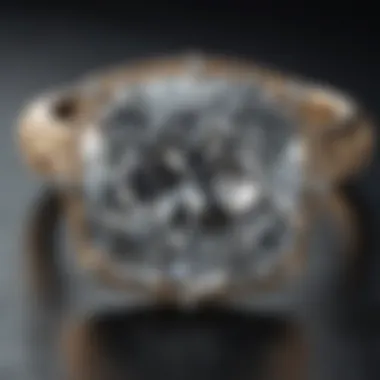
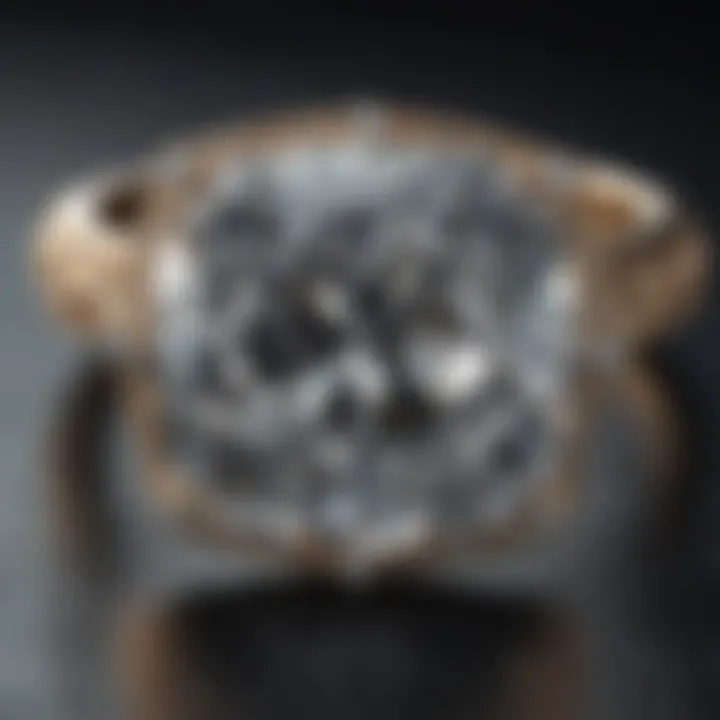
One of the most compelling reasons people gravitate towards moissanite over diamonds is the price point. Moissanite is significantly less expensive, making it an attractive option for those mindful of budget without wanting to compromise on visual impact.
- Cost Efficiency: A larger or higher-quality moissanite can often be acquired for a fraction of a comparable diamond’s price.
- Resale Value: Diamonds tend to maintain or even appreciate in value over time. Moissanite, while wonderful, typically does not have the same resale potential due to its lower demand in the luxury market.
In the end, the choice reflects personal values—whether one prioritizes economic practicality or the traditional allure and potential investment value of diamonds.
"The choice between moissanite and diamond invites a deeper inquiry into one’s personal values and preferences, beyond just the price tag."
With engaging visual splendor, commendable durability, and notable value considerations, both moissanite and diamonds offer their distinct allure. The decision, therefore, isn't just about which stone is superior; it’s about finding the right fit for one’s personal journey in the world of gemstones.
The Market for Moissanite
The rise in popularity of moissanite has transformed it from a rare find into a widely sought-after gemstone. Understanding the market for moissanite is crucial for various stakeholders, including buyers, jewelers, and investors. It illuminates not just the aesthetic appeal of this stone but also its economic feasibility, making it a worthy alternative to diamonds and other precious gems.
With ongoing advancements in technology and craftsmanship, more individuals are gravitating towards moissanite, attracted by its beauty and cost-effectiveness. This growing trend reflects a shift in consumer preferences, where environmental concerns and budget considerations are at the forefront of purchasing decisions.
Current Trends
Moissanite's market trends give a glimpse into its evolving status in the jewelry world. Here are a few notable trends:
- Sustainability: Many consumers are now prioritizing eco-friendly products. Moissanite, being lab-created, offers a conflict-free alternative that appeals to environmentally-aware buyers. The ethical considerations related to gem mining are pushing many people towards these lab-grown options.
- Customization: Jewelers are noticing a surge in demand for customized moissanite pieces. Buyers are eager to express their individuality through personalized designs, leading to a growing market for bespoke jewelry.
- Hybrid Sales: Online jewelry stores are collaborating with brick-and-mortar businesses to create hybrid shopping experiences. Customers appreciate the flexibility of online browsing paired with in-person consultations to view moissanite pieces.
"As more people become aware of moissanite, it’s clear that consumer behavior is evolving, emphasizing quality, sustainability, and individuality."
Pricing Insights
Pricing is a significant aspect to consider when delving into the moissanite market. Unlike diamonds, which are often subject to market fluctuations, moissanite tends to maintain more stable pricing patterns. This stability can be attributed to its consistent supply and regulated production.
Key points to consider:
- Affordability: Generally, moissanite is priced anywhere from 10% to 30% of what a diamond costs, depending on the size and quality. This price differential makes moissanite an appealing choice for those looking to get maximum value for their money.
- Value Retention: While moissanite does not hold its value in the same fashion as diamonds, its steady demand implies that it can still be considered a sound investment, especially given the trends of adornment and personalized jewelry.
When evaluating pricing, potential buyers should also keep an eye on:
- The quality of the moissanite, which can significantly influence the price.
- The reputation and craftsmanship of the retailer, as these factors can affect overall purchase satisfaction.
Trusted Brands and Retailers
When it comes to purchasing moissanite, the importance of trusted brands and retailers cannot be overstated. With the rising popularity of moissanite as a diamond alternative, it's essential to choose a reputable source to ensure the quality and authenticity of your stone. What sets credible brands apart? They offer not just high-quality products but also a level of customer service that enhances the buying experience. A trustworthy retailer typically provides comprehensive information about their offerings, including detailed specifications, certification, and return policies. This builds confidence and helps avoid the pitfalls that can often accompany purchases of synthetic gemstones.
Key Recommendations
When selecting a retailer for moissanite, consider these key recommendations:
- Research the Brand’s Reputation: Look for customer reviews and ratings on platforms like Reddit and Facebook. Positive feedback from previous buyers can indicate reliability.
- Examine Certification Standards: Ensure the moissanite comes with proper certification from recognized authorities. This distinguishes genuine stones from subpar imitations.
- Evaluate Customer Support: A reputable brand should provide easy access to knowledgeable support staff. This is crucial if you have questions during the buying process.
- Review Return and Warranty Policies: Flexible return and warranty options demonstrate a company's confidence in their products, adding an extra layer of protection for your investment.
Where to Buy Moissanite
Locating a credible source for moissanite can seem daunting, but there are numerous options available to gemstone enthusiasts:
- Online Retailers: Websites like James Allen and Brilliant Earth offer extensive selections of moissanite, along with customizable options to fit personal preferences.
- Local Jewelry Stores: Visiting a local jeweler can allow you to see the stone up close. Many jewelers now stock moissanite alongside traditional gemstones, offering personalized guidance.
- Specialty Moissanite Dealers: Companies such as MoissaniteCo specialize in moissanite products, providing an extensive range of choices for shoppers.
Additionally, always keep an eye out for sales or promotional offers, as prices can vary significantly even within trusted brands.
"Finding the right moissanite is like finding the right partner; it takes time, trust, and a little bit of luck."
By focusing on positive purchasing experiences and selecting reputable retailers, consumers equip themselves with not only a beautiful gemstone but peace of mind that comes from making informed choices.
Customer Reviews of Moissanite
The section on customer reviews of moissanite is crucial for anyone considering this gemstone in their jewelry choices. As potential buyers gather information, real-world experiences can shed light on both the merits and shortcomings of moissanite. Customer feedback represents a valuable resource, providing insights into the overall satisfaction with the stone, its durability, how it holds up over time, and the emotional responses it elicits from those who wear it. Moreover, reviews help bridge the gap between theoretical knowledge and practical application. They can influence decisions, particularly for those hesitant about making such an investment.
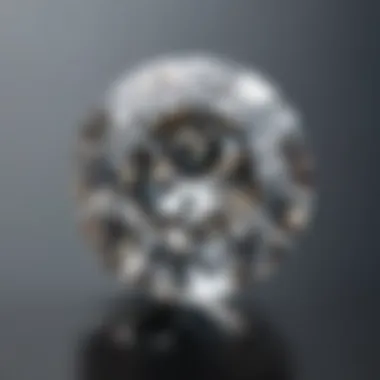
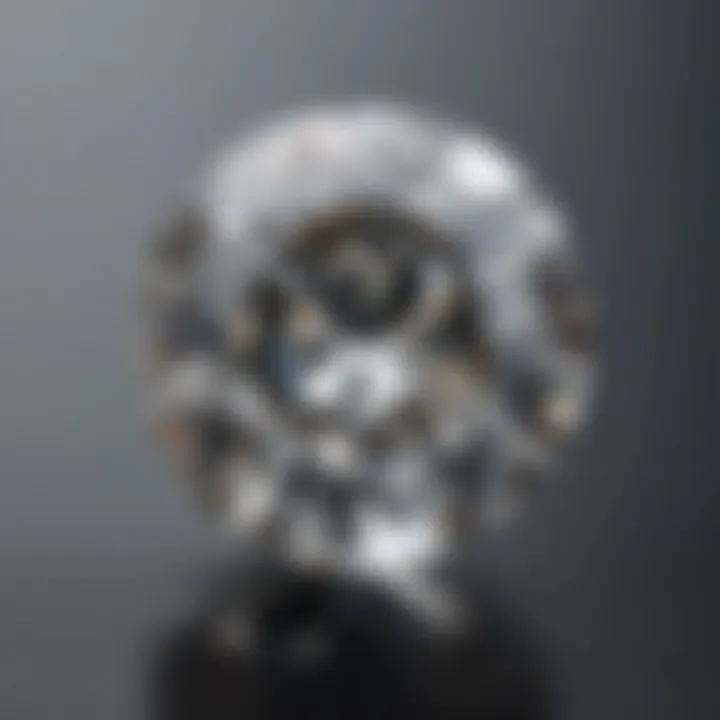
As buyers weigh their options, they often look for reassurance in the experiences of others. By sharing personal stories and opinions, customers can highlight the core attributes of moissanite that align with their expectations or bring to light aspects that might not be evident from purely technical discussions. Let's delve into the positive feedback that many have for this intriguing gemstone, followed by the common concerns that surface in discussions about moissanite.
Positive Feedback
There is a significant amount of positive sentiment in customer reviews regarding moissanite. This section reveals aspects many users appreciate:
- Affordability: Numerous buyers highlight how they received similar brilliance and quality to diamonds at a fraction of the price, making moissanite an attractive option for budget-conscious consumers.
- Sparkle and Brilliance: Many wearers frequently rave about the exceptional sparkle that moissanite offers, with comparisons often drawn to natural diamonds. Users often express satisfaction with the stone's ability to catch light and draw attention.
- Durability: Although moissanite is not a diamond, its high hardness rating (9.25 on the Mohs scale) affirms that it stands up well against daily wear and tear. Customers often comment on how well their rings or jewelry maintain their beauty over the years.
- Environmentally Friendly Choice: Some buyers appreciate that moissanite is a lab-created gemstone. This aspect appeals to environmentally conscious individuals looking for alternatives to mined stones that can contribute to environmental degradation.
Notably, many positive reviews also address the overall customer service experience. Several retail brands noted for their exceptional support have garnered considerable recognition.
Common Concerns
Despite the glowing reviews, not all experiences are universally positive. It’s essential to consider the common concerns raised by customers, which include:
- Color Variability: Some users mention that certain moissanite stones can exhibit a tint, depending on the quality and grading. While higher-quality moissanite can have near-colorless appearances, some lower-grade options might lean towards a yellowish hue.
- Comparison to Diamonds: Although many appreciate moissanite, others feel that when closely compared to diamonds, the unique qualities of diamonds may not be fully replicated. Buyers should be aware that while moissanite is stunning, it does have its distinct characteristics.
- Setting Options: Occasionally, buyers express challenges in finding specific settings that suit moissanite’s unique attributes. This can limit choices, especially for custom jewelry.
- Longevity of Sparkle: A few customers have noted that while the initial brilliance is captivating, they have concerns regarding whether it retains its ‘like-new’ sparkle over the years. Routine maintenance and care must be emphasized.
In essence, while moissanite has carved out a place for itself in the gemstone market, it’s essential for potential buyers to arm themselves with insights from existing users. Thus, they can make an informed, confident choice, ultimately ensuring their purchase aligns with their desires and expectations.
Care and Maintenance of Moissanite
Taking care of moissanite is essential to ensure its brilliance and longevity. Though moissanite is a durable gemstone, it still requires regular cleaning and attention to keep it looking its best. Neglecting proper maintenance can lead to loss of luster or even damage over time. In this section, we will discuss effective cleaning techniques, essential storage tips, and the overall importance of maintaining your moissanite to preserve its beauty.
Cleaning Techniques
Cleaning moissanite is a straightforward process that can be done at home without breaking the bank. Here are some techniques to keep your gem sparkling:
- Soapy Water Soak: Mixing warm water with a mild dish soap makes an excellent solution for cleaning moissanite. Soak the jewelry for about 20–30 minutes, then gently scrub with a soft toothbrush. This helps remove any oils or dirt that may have accumulated.
- Ultrasonic Cleaners: For a deeper clean, ultrasonic cleaners can be effective. Just ensure you follow the manufacturer's instructions and verify that your piece is safe for this method.
- Professional Cleaning: If your moissanite is set in an intricate design or you’re unsure how to clean it properly, seeking professional help can ensure that the cleaning is done safely. Many jewelers offer complimentary cleaning services for customers.
"Keeping your moissanite clean is not just about aesthetics; it’s also about maintaining its sparkle and clarity for years to come."
Storage Tips
How you store your moissanite plays a significant role in its overall condition. Proper storage can prevent scratches and other damage that can occur if the stone is not adequately protected. Consider these tips:
- Use a Soft Cloth: Wrap your moissanite in a soft cloth when not in use to avoid scratches from other jewelry. Avoid using paper towels or rough fabrics that could wear the surface.
- Separate Storage: Keep moissanite jewelry separate from other pieces, especially harder gemstones like diamonds, which can scratch the surface of the moissanite. Consider using individual compartments in a jewelry box or soft pouches.
- Avoid Extreme Temperatures: Store your moissanite away from extreme heat or direct sunlight, as it can help maintain its integrity and color.
In summary, properly caring for moissanite enhances the durability and preservation of its striking appearance. From simple cleaning methods to careful storage techniques, a bit of attention will go a long way in keeping this gem radiant.
Metaphysical Aspects of Moissanite
When discussing gemstones, we often focus on their physical properties and aesthetic appeal. However, the metaphysical aspects of moissanite deserve equal attention. For many, the beauty of a stone transcends mere appearance, tapping into deeper beliefs and symbolism. Some enthusiasts believe that moissanite carries specific energies that can enhance one’s life journey.
This section provides insight into the spiritual significance of moissanite, exploring its purported benefits and how it is perceived in various traditions.
Beliefs and Traditions
Moissanite is said to embody numerous metaphysical properties that add another layer to its allure. These beliefs might vary across cultures but often share common themes. Here are some points to consider:
- Bringer of Clarity: Many believe that moissanite promotes clarity of thought. It is thought to help individuals make tough decisions by providing mental acuity and removing emotional fog.
- Energy Amplifier: Some see moissanite as a tool for amplifying one’s energy, especially during meditation. Its high refractive index may metaphorically mirror the increased vibrational state one can achieve while focusing on their goals.
- Protection Stone: Traditionally, certain gemstones are considered to offer protection. Moissanite is sometimes viewed as a shield against negative energies, promoting personal power and confidence.
- Symbol of Love: Given its stunning brilliance and durability, moissanite has found its way into the hearts of many as a less conventional option for engagement rings. This choice is often paired with the belief that it represents everlasting love and commitment.
When one wears moissanite, they may feel connected to these ideas and energies. Each stone carries its own history and potential, which can be deeply personal. Those who seek to integrate moissanite into their lives often do so with the intention of harnessing its properties, whether for practical or spiritual reasons.
"Gemstones have the power to influence energies and emotions, shaping our experiences and intentions."
In various traditions, moissanite is discussed alongside other gemstones known for their metaphysical properties. It is often grouped with stones that emphasize personal growth, protection, and spiritual awareness. This makes moissanite not only a fantastic alternative to diamonds in material terms but also an intriguing choice in metaphysical practices.
Ultimately, how one chooses to engage with these beliefs surrounding moissanite is entirely personal. For some, it may be about aesthetics, while for others, it could be a profound spiritual connection. The unique combination of its beauty and the rich tapestry of meanings within the realm of the metaphysical makes moissanite a fascinating subject to delve into.
Culmination
As we wrap up our exploration of moissanite, it's essential to understand the critical role this gemstone plays in the modern jewelry market. Unlike what many think, moissanite isn't just a synthetic stand-in for diamonds; it has its own distinct charm and advantages. This article has sought to illuminate those features, helping potential buyers and enthusiasts appreciate moissanite's unique characteristics.
Final Thoughts on Moissanite
Choosing moissanite can be an excellent decision. It offers exceptional brilliance and fire comparable to diamonds, often at a fraction of the price. The durability of moissanite ensures it stands the test of time, making it ideal for everyday wear. Moreover, it appeals to consumers increasingly conscious about ethical sourcing, as most moissanite on the market is lab-grown, reducing the impact on earth and communities.
Additionally, the growing popularity of moissanite has led to a surge in innovative designs and settings, expanding options for jewelers and customers alike. As consumer education evolves, it's clear that those in the market for a stunning gemstone will find much to love in moissanite.
Ultimately, when considering an investment in gemstones, potential buyers should recognize that moissanite offers significant value and beauty without the hefty price tag associated with traditional diamonds. Delving into its attributes not only reveals a worthy contender to diamonds but suggests a shift in how we perceive luxury and sustainability in jewelry.







